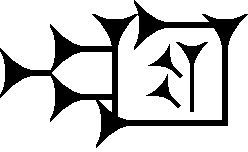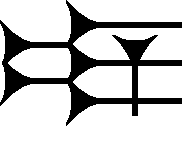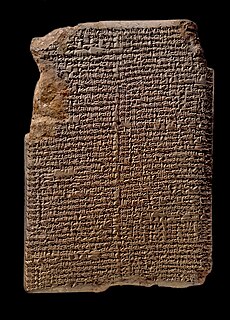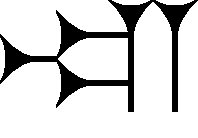 W
WThe cuneiform DAGAL sign, which is a capital letter (majuscule) Sumerogram with the Akkadian language meaning of to be wide, or extensive; also "many", Akkadian "rapāšu", is a minor usage cuneiform sign used in the Amarna letters and the Epic of Gilgamesh. An equivalent usage sign for DAGAL is used in the Amarna letters, gáb, for Akkadian language "gabbu", and is found in such letters as EA 362, EA 367, and others. Gáb has other syllabic values, which are used for separate Akkadian word components.
 W
WARADh, is the capital letter-(majuscule) Sumerogram for the Akkadian language word "ardu", for servant. It is used especially in the introduction to the Pharaoh: for example "To King, Lord-mine, message thus Xxxxxx, "Servant-yours"-(271). It is also used extensively in Amarna letter texts, the author, usually the "man of a city",, where there is a constant reminder that he is a "servant", or "servant-yours"-(of the Pharaoh). Many letters are giving city-state status reports, but many are also requesting help with the Egyptian army troops-(Archers, supplied by the Pharaoh).
 W
WThe cuneiform ud sign, also ut, and with numerous other syllabic uses, as well as multiple sumerogramic uses is a common sign for the mid 14th-century BC Amarna letters and the Epic of Gilgamesh. The sign is constructed upon the single vertical stroke , with various positionings of two wedge-strokes at the left, sometimes approximately centered, or often inscribed upwards to the left, the second wedge-stroke, occasionally inscribed/ligatured upon the first. The wedge-strokes can have any size, are often smaller than the vertical, but as an example, Amarna letter EA 256, can be almost as large as the vertical.
 W
WThe cuneiform DAGAL sign, which is a capital letter (majuscule) Sumerogram with the Akkadian language meaning of to be wide, or extensive; also "many", Akkadian "rapāšu", is a minor usage cuneiform sign used in the Amarna letters and the Epic of Gilgamesh. An equivalent usage sign for DAGAL is used in the Amarna letters, gáb, for Akkadian language "gabbu", and is found in such letters as EA 362, EA 367, and others. Gáb has other syllabic values, which are used for separate Akkadian word components.
 W
WThe cuneiform sign for tur is used to denote one syllabic usage, tur, or the sign's Sumerograms; it is used in the Epic of Gilgamesh and the 14th century BC Amarna letters. The sign is based on the i (cuneiform) sign, with the one small added vertical stroke.
 W
WERIM is the capital letter-(majuscule) Sumerogram for the Akkadian language word army, or "troops". The akkadian language word for army is ; consequently the cuneiform character for ERIM is also equivalent to sab, zab, etc.-(also using s-dot).
The cuneiform dan sign is a multi-use sign found in both the 14th century BC Amarna letters and the Epic of Gilgamesh. Besides dan,, the following are its uses :dan kal lab lap lép líb líp reb rib tan GURUŠ-(GURUŠ
 W
WThe cuneiform sign KÁ, for gate is the Sumerogram-(logogram) used in the Amarna letters and the Epic of Gilgamesh; as just KÁ it means "gate" or "doorway", Akkadian language, "bābu"; as "Gate-Great", KÁ.GAL for City-Gate, it is from Akkadian "abullu",. Both uses are in the Epic of Gilgamesh. In the Epic, it is only used as the sumerogram, a total of 19 times,. In the Epic, all spellings for city gate use KÁ.GAL; for gate ('bābu') only one spelling uses the alphabetic letters for b-a-b-u; the rest use KÁ along with other added cuneiform signs.
 W
WThe cuneiform KÚR sign is used extensively in the Amarna letters. It also has a minor usage in the Epic of Gilgamesh. Its usage in the Amarna letters is due to the letters' topics of "hostilities", "war", or "warfare" in the discord amongst the city-states and the regional discord in the Canaan region. A large subset of the Amarna letters are written by vassal kings in governorship of cities, towns or regions in Canaan.
 W
WThe cuneiform KÚR sign is used extensively in the Amarna letters. It also has a minor usage in the Epic of Gilgamesh. Its usage in the Amarna letters is due to the letters' topics of "hostilities", "war", or "warfare" in the discord amongst the city-states and the regional discord in the Canaan region. A large subset of the Amarna letters are written by vassal kings in governorship of cities, towns or regions in Canaan.
 W
WThe cuneiform sign LÚ is the sign used for "man"; its complement is the symbol for woman: šal. Cuneiform LÚ, is found as a Sumerogram in the Epic of Gilgamesh. It also has a common usage in the 1350 BC Amarna letters as the Sumerogram for "man".
 W
WThe cuneiform sign MÁ denotes a ship or boat. It is used in Sumerian and as a Sumerogram for the Akkadian word eleppu. MÁ is usually preceded by the determinative for items made of wood, namely GIŠ: GIŠ.MÁ, or GIŠ.MÁ, .
 W
WMUL.APIN is the conventional title given to a Babylonian compendium that deals with many diverse aspects of Babylonian astronomy and astrology. It is in the tradition of earlier star catalogues, the so-called Three Stars Each lists, but represents an expanded version based on more accurate observation, likely compiled around 1000 BCE. The text lists the names of 66 stars and constellations and further gives a number of indications, such as rising, setting and culmination dates, that help to map out the basic structure of the Babylonian star map.
 W
WMUNUS, 𒊩, or SAL is the capital-letter (majuscule) Sumerogram for the Akkadian language word "ṣuhārtu", young woman, or woman. The word is commonly used in the Amarna letters diplomatic letters, as well as elsewhere, for example in the Epic of Gilgamesh.
 W
WThe Sumerian word NIN (𒎏) was used to denote a queen or a priestess, and is often translated as "lady". Other translations include "queen", "mistress", "proprietress", and "lord".
 W
WThe cuneiform ud sign, also ut, and with numerous other syllabic uses, as well as multiple sumerogramic uses is a common sign for the mid 14th-century BC Amarna letters and the Epic of Gilgamesh. The sign is constructed upon the single vertical stroke , with various positionings of two wedge-strokes at the left, sometimes approximately centered, or often inscribed upwards to the left, the second wedge-stroke, occasionally inscribed/ligatured upon the first. The wedge-strokes can have any size, are often smaller than the vertical, but as an example, Amarna letter EA 256, can be almost as large as the vertical.
 W
WThe cuneiform sign URU is a relatively distinctive sign in the cuneiform sign lists; with its two verticals at the sign's right, and the central long horizontal stroke, it is not easily confused with other signs. It is commonly found in the intrigues of the 14th century BC Amarna letters since the letters often concern city-state locations, or surrounding regions or cities/towns. URU is also used in the Epic of Gilgamesh. The cuneiform sign is almost exclusively used as a Sumerogram, and in the Akkadian language, it is the Akkadian for "ālu", city, or town. The usage of URU in the Epic of Gilgamesh is only for Sumerogram "URU",. All uses in the Epic for URU are for various spellings of ālu, and usually an added sign complement; there is one usage in the Epic of URU for the city Shuruppak: URU.Šu-ri-ip-pak,.
 W
WThe cuneiform ud sign, also ut, and with numerous other syllabic uses, as well as multiple sumerogramic uses is a common sign for the mid 14th-century BC Amarna letters and the Epic of Gilgamesh. The sign is constructed upon the single vertical stroke , with various positionings of two wedge-strokes at the left, sometimes approximately centered, or often inscribed upwards to the left, the second wedge-stroke, occasionally inscribed/ligatured upon the first. The wedge-strokes can have any size, are often smaller than the vertical, but as an example, Amarna letter EA 256, can be almost as large as the vertical.